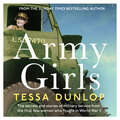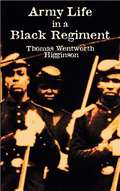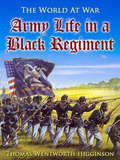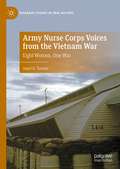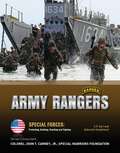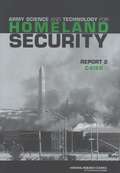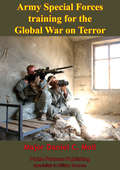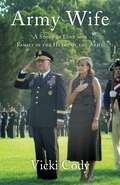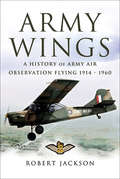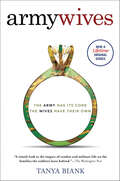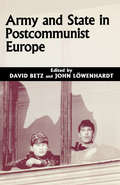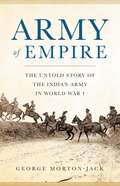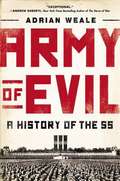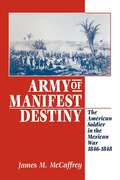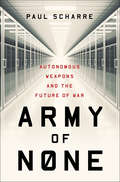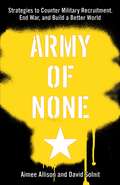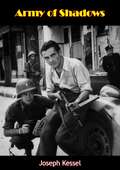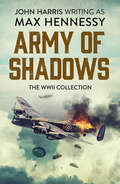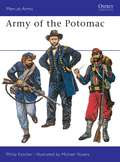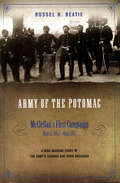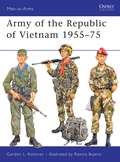- Table View
- List View
Army Girls: The secrets and stories of military service from the final few women who fought in World War II
by Tessa DunlopArmy Girls is the intimate story of the final few women who served in World War II and are still alive to tell their tale. They were female soldiers in a war Britain wanted to fight without conscripting women. It was a vain hope, by December 1941 for the first time in British history women were called up and a generation of girls came of age in khaki, serving king and country. Barbara trained to drive army-style in giant trucks and Grace swapped her servant's pinafore for battledress and a steel hat, Martha turned down officer status for action on a gun-site and Olivia won the Croix de Guerre in France.Commemorating the 80th anniversary of conscription for women, Army Girls captures remarkable stories from the last surviving veterans who served in Britain's female army and brings to life a pivotal moment in British history. Precious memories and letters are entwined in a rich narrative that travels back in time and sheds new light on being young, female and at war.Uniquely this moving Second World War memoir is embedded in the present day. Written in the midst of a global pandemic, the parallels and paradoxes between two very different national crises are explored in a book that honours the women who fought on in extreme youth and now once more in great old age.(P) 2021 Headline Publishing Group Ltd
Army JROTC Leadership Education and Training (LET #3)
by Pearson Custom PublishingArmy JROTC Leadership Education and Training (LET 3) Third Year of A Character and Leadership Development Program
Army JROTC Leadership Education and Training, First Year
by Pearson Custom PublishingThis book introduces you to the U.S. Army Junior Reserve Officers' Training Corps (JROTC) Program, its mission, and the Leadership Education and Training (LET) curriculum for this first level of your instruction. Completing the material in this course requires discipline and hard work, but the reward is well worth your effort. Through Army JROTC, you are building a foundation that will last a lifetime.
Army Life in a Black Regiment (Civil War)
by Thomas Wentworth Higginson"Army Life in a Black Regiment has some claim to be the best written narrative to come from the Union [side] during the Civil War. Higginson's picture of the battle which was the origin of "praise the Lord and pass the ammunition" and his reading of the Emancipation Proclamation to the black regiment are unsurpassed for eloquence." — historian Henry Steele CommagerOriginally a series of essays, this important volume was written by a Union colonel from New England, in charge of African-American troops training on the Sea Islands off the coast of the Carolinas. A lively and detailed wartime diary, the book offers a refreshing portrait of life in the Union Army from an officer's point of view, recording opinions of other commanders and capturing the raw humor that develops among the men in combat. Higginson's descriptions of the soldiers, routines of camp life, and southern landscapes are unforgettable, as is the account of his near escape from a cannon ball. An unusual historical document intended to introduce new generations of readers to an American past that should not be forgotten, Army Life in a Black Regiment will be invaluable to students of Black History and the American Civil War.
Army Life in a Black Regiment (The World At War)
by Thomas Wentworth HigginsonThomas Wentworth Higginson (December 22, 1823 – May 9, 1911) was an American Unitarian minister, author, abolitionist, and soldier. He was active in the American Abolitionism movement during the 1840s and 1850s, identifying himself with disunion and militant abolitionism. He was a member of the Secret Six who supported John Brown. During the Civil War, he served as colonel of the 1st South Carolina Volunteers, the first federally authorised black regiment, from 1862–1864. Following the war, Higginson devoted much of the rest of his life to fighting for the rights of freed slaves, women and other disfranchised peoples. (Excerpt from Wikipedia)
Army Nurse Corps Voices from the Vietnam War: Eight Women, One War (Palgrave Studies in Oral History)
by Janet D. TannerThis book provides an oral history of women who served in the U.S. Army Nurse Corps during the Vietnam War. It follows the trajectory of eight women’s lives from their decision to become nurses, to surgical and evacuation hospitals in Vietnam, and then home to face the consequences of war on their personal and professional lives. It documents their lived experience in Vietnam and explores the memories and personal stories of nurses who treated injured American soldiers, Vietnamese civilians, and the enemy. Their voices reveal the physical and emotional challenges, trauma, contradictions, and lingering effects of war on their lives. Women in the U.S. Army in Vietnam feared the enemy but also sexual violence and harassment: the experiences this book documents also shed light on the extent of historical sexual abuse in the military.
Army Rangers (Special Forces: Protecting, Building, Te)
by C. F. EarlThe Rangers are some of the best-trained and most skilled soldiers in the Army. Their motto--Rangers lead the way!--is not just a slogan; in many of the modern conflicts in which the U.S. military has been involved, the Rangers have been among the first soldiers on the ground. In both Iraq and Afghanistan, Rangers carry out raid, ambush, and rescue missions, as well as many other kinds of operations. Army Rangers gives readers a view into the world of the highly skilled Seventy-Fifth Ranger Regiment, today's Rangers, as well as a look at the history of the unit. Since the Revolutionary War, Ranger tactics and standards have been some of the most effective in the entire military. The book also includes information about: * The tough training courses that all Rangers must endure. * What kinds of weapons the Rangers use today and throughout history. * How the modern Rangers were organized and put into action around the world.
Army Science And Technology For Homeland Security: Report 2
by Committee on Army Science Technology for Homeland Defense--C4ISRShortly after the events of September 11, 2001, the U.S. Army asked the National Research Council (NRC) for a series of reports on how science and technology could assist the Army meet its Homeland defense obligations. The first report, Science and Technology for Army Homeland Security—Report 1, presented a survey of a road range of technologies and recommended applying Future Force technologies to homeland security wherever possible. In particular, the report noted that the Army should play a major role in providing emergency command, control, communications, computers, intelligence, surveillance, and reconnaissance (C4ISR) capabilities and that the technology and architecture needed for homeland security C4ISR was compatible with that of the Army’s Future Force. This second report focuses on C4ISR and how it can facilitate the Army’s efforts to assist the Department of Homeland Security (DHS) and emergency responders meet a catastrophic event.
Army Special Forces Training For The Global War On Terror
by Major Daniel C. MollWith USSOCOM assuming the role as supported command in the Global War on Terror, Army Special Forces will no doubt to play a primary role in that effort. The unspoken assumption seems to be that America's new, unconventional foe will best be combated with America's own unconventional warriors. It is unclear, however, if a force raised to conduct behind-the-lines operations against a large conventional enemy will remain the force of choice against al-Qaida and similar threats. This thesis' central research question is: Is US Army Special Forces adequately prepared, and trained to fight the Global War on Terror? This thesis examines the contemporary operating environment, the threat represented by al-Qaida, and whether it represents a traditional terrorist threat or a new, transnational insurgency. A review of both types of organization over the last century indicates that al-Qaida is, at this stage, merely a terrorist organization, and not an insurgency. However, al-Qaida sprang from a region that is ripe for insurgency should the terrorists choose to become more than what they currently are. Combating the threat posed by al-Qaida, then, seems to require both an aggressive counter-terrorist campaign and a simultaneous pre-emptive counter-insurgency. A review of current training indicates that Special Forces appears well prepared for both efforts with one glaring deficiency: foreign language proficiency.
Army Wife: A Story of Love and Family in the Heart of the Army
by Vicki CodyFrom the last days of the Vietnam War to the present-day war on terrorism, this story is a moving and poignant tribute to love, marriage, family, and the men and women who serve this nation. In describing her thirty-three-year journey as an Army wife, Cody gives an in-depth look at what it takes to keep a marriage strong, raise a family—oftentimes as a single parent—create a home, and face separations and loneliness amid the uncertainty and stresses that are so much a part of Army life. Over the years, Cody learns to embrace the uniqueness of her circumstances, and she finds joy, self-fulfillment, and pride in her role. But when both her sons follow in their dad&’s footsteps, becoming Army Aviators and flying Apache helicopters in combat zones in Afghanistan and Iraq, Cody faces her greatest challenges as a mother and again, must balance the needs of her family with her husband&’s position. Full of humor and honesty, Army Wife brings the reader into Cody&’s private life in a very personal way, and in doing so opens the lens for a broader view of world events.
Army Wings: A History of Army Air Observation Flying, 1914–1960
by Robert JacksonThis is the fascinating story of army fixed-wing cooperation units who were made up of specially trained volunteer army personnel. These men were trained to fly, to reconnoiter across the front line in search of enemy forces and then guide artillery gunners onto the target.From its earliest days in World War I, small low-flying aircraft have flown unarmed into combat and relayed vital information to aid accurate fall of shot and to advise front-line ground troops of enemy strength and position. They were frequently attacked by fighter aircraft and had to avoid ground-fire, often flying below treetop height. They relied purely on flying skill to outwit the enemy and yet little is known of these unsung heroes of many wars. This book redresses the balance.
Army Wives: The Unwritten Code Of Military Marriage
by Tanya BiankArmy Wives goes beyond the sound bites and photo ops of military life to bring readers into the hearts and homes of today's military wives. Biank tells the story of four typical Army wives who, in a flash, find themselves in extraordinary circumstances that ultimately force them to redefine who they are as women and wives. This is a true story about what happened when real life collided with army convention.Army Wives is a groundbreaking narrative that takes the reader beyond the Army's gates, taking a close look at the other woman—the Army itself—and how its traditions, rules and war-time realities deeply impact marriage and home life.
Army and Nation: The Military and Indian Democracy since Independence
by Steven I. WilkinsonSteven I. Wilkinson explores how India has succeeded in keeping the military out of politics, when so many other countries have failed. He uncovers the command and control strategies, the careful ethnic balancing, and the political, foreign policy, and strategic decisions that have made the army safe for Indian democracy.
Army and Society in Ptolemaic Egypt
by Christelle Fischer-BovetThis is the only substantial and up-to-date reference work on the Ptolemaic army. Employing Greek and Egyptian papyri and inscriptions, and building on approaches developed in state-formation theory, it offers a coherent account of how the changing structures of the army in Egypt after Alexander's conquest led to the development of an ethnically more integrated society. A new tripartite division of Ptolemaic history challenges the idea of gradual decline, and emphasizes the reshaping of military structures that took place between c. 220 and c. 160 BC in response to changes in the nature of warfare, mobilization and demobilization, and financial constraints. An investigation of the socio-economic role played by soldiers permits a reassessment of the cleruchic system and shows how soldiers' associations generated interethnic group solidarity. By integrating Egyptian evidence, Christelle Fischer-Bovet also demonstrates that the connection between the army and local temples offered new ways for Greeks and Egyptians to interact.
Army and State in Postcommunist Europe
by David Betz John LöwenhardtThis study explores the complex military issues that are raised by the transition to post-communist rule with particular reference to Russia, Ukraine, Bulgaria, and the new members of NATO. All faced similar problems yet their responses, it emerges, were surprisingly diverse.
Army of Empire: The Untold Story of the Indian Army in World War I
by George Morton-JackDrawing on untapped new sources, the first global history of the Indian Expeditionary Forces in World War IWhile their story is almost always overlooked, the 1.5 million Indian soldiers who served the British Empire in World War I played a crucial role in the eventual Allied victory. Despite their sacrifices, Indian troops received mixed reactions from their allies and their enemies alike-some were treated as liberating heroes, some as mercenaries and conquerors themselves, and all as racial inferiors and a threat to white supremacy. Yet even as they fought as imperial troops under the British flag, their broadened horizons fired in them new hopes of racial equality and freedom on the path to Indian independence. Drawing on freshly uncovered interviews with members of the Indian Army in Iraq and elsewhere, historian George Morton-Jack paints a deeply human story of courage, colonization, and racism, and finally gives these men their rightful place in history.
Army of Evil: A History of the SS
by Adrian WealeIn Nazi Germany, they were called the Schutzstaffel. The world would know them as the dreaded SS—the most loyal and ruthless enforcers of the Third Reich… It began as a small squad of political thugs. Yet by the end of 1935, the SS had taken control of all police and internal security duties in Germany—ranging from local village “gendarmes” all they way up to the secret political police and the Gestapo. And by 1944 the militarized Waffen SS had more than eight hundred thousand men serving in the field, even rivaling Germany’s regular armed forces, the Wehrmacht. In Army of Evil: A History of the SS, author Adrian Weale delves into materials not previously available, including recently released intelligence files, the most up-to-date research and rare and never-before-published photographs. Going beyond the myths and characterizations, this comprehensive account reveals the reality of the SS as a cadre of unwavering political fanatics and power-seeking opportunists who slavishly followed an ideology that disdained traditional morality, and were prepared to implement it to the utmost, murderous extreme that ultimately resulted in the Holocaust. This is a definitive historical narrative of the birth, legacy, and ultimate demise of one of the most feared political and military organizations ever known, and those twisted, cruel men who were responsible for one of the most appalling crimes against humanity in all history. .
Army of Manifest Destiny: The American Soldier in the Mexican War, 1846-1848 (The American Social Experience #11)
by James M. MccaffreyThe day-to-day experiences of the American soldiers fighting in the Mexican WarJames McCaffrey examines America's first foreign war, the Mexican War, through the day-to-day experiences of the American soldier in battle, in camp, and on the march. With remarkable sympathy, humor, and grace, the author fills in the historical gaps of one war while rising issues now found to be strikingly relevant to this nation's modern military concerns.
Army of None: Autonomous Weapons And The Future Of War
by Paul ScharreA Pentagon defense expert and former U.S. Army Ranger explores what it would mean to give machines authority over the ultimate decision of life or death. <P><P> What happens when a Predator drone has as much autonomy as a Google car? Or when a weapon that can hunt its own targets is hacked? Although it sounds like science fiction, the technology already exists to create weapons that can attack targets without human input. Paul Scharre, a leading expert in emerging weapons technologies, draws on deep research and firsthand experience to explore how these next-generation weapons are changing warfare. <P><P> Scharre’s far-ranging investigation examines the emergence of autonomous weapons, the movement to ban them, and the legal and ethical issues surrounding their use. He spotlights artificial intelligence in military technology, spanning decades of innovation from German noise-seeking Wren torpedoes in World War II—antecedents of today’s homing missiles—to autonomous cyber weapons, submarine-hunting robot ships, and robot tank armies. Through interviews with defense experts, ethicists, psychologists, and activists, Scharre surveys what challenges might face "centaur warfighters" on future battlefields, which will combine human and machine cognition. We’ve made tremendous technological progress in the past few decades, but we have also glimpsed the terrifying mishaps that can result from complex automated systems—such as when advanced F-22 fighter jets experienced a computer meltdown the first time they flew over the International Date Line. <P><P>At least thirty countries already have defensive autonomous weapons that operate under human supervision. Around the globe, militaries are racing to build robotic weapons with increasing autonomy. The ethical questions within this book grow more pressing each day. To what extent should such technologies be advanced? And if responsible democracies ban them, would that stop rogue regimes from taking advantage? At the forefront of a game-changing debate, Army of None engages military history, global policy, and cutting-edge science to argue that we must embrace technology where it can make war more precise and humane, but without surrendering human judgment. When the choice is life or death, there is no replacement for the human heart.
Army of None: Strategies to Counter Military Recruitment, End War, and Build a Better World
by David Solnit Aimee AllisonUniformed U.S. Army Officers lunch with students in elementary school cafeterias. Army training programs including rifle and pistol instruction replace physical education in middle schools. Like never before, military recruiters are entering the halls of U.S. schools with unchecked access in an attempt to bolster a military in crisis.However, even as these destructive efforts to militarize youth accelerate, so do the creative and powerful efforts of students, community members, and veterans to challenge them. Today, the counter recruitment movement--from counseling to poetry slams to citywide lobbying efforts--has become one of the most practical ways to tangibly resist U.S. policy that cuts funding for education and social programs while promoting war and occupation. Without enough soldiers, the U.S. cannot sustain its empire.Army of None exposes the real story behind the military-recruitment complex, and offers guides, tools, and resources for education and action, and people power strategies to win.
Army of Shadows
by Joseph Kessel Haakon ChevalierTHIS IS THE TRUTH, THOUGH THE FORM IS FICTION…The terrible and inspiring truth about the French underground, the way it’s men and women operate, fight, die, a story full of nobility, heroism, and brutal violence.First published in its English translation in 1944, this is the fictionalized account of French writer Joseph Kessel’s own experiences as a member of the French Resistance in World War II.
Army of Shadows: The WWII Collection
by Max HennessyGetting shot down is just the beginning in this epic story of survival and resistance in a country crawling with Nazi soldiers during the Second World War. They fought without glory—and without mercy. France, Winter 1944: The long-awaited liberation is at hand. The bombing missions had gone well, and the crew of the Lancaster bomber had begun to relax. Then the Messerschmitt came out of the darkness, its guns blazing. Of the nine-man crew only Neville and Urquhart survive, parachuting into the heart of occupied France. Joining forces with the men of the French Resistance, they must enter a deadly game of cat and mouse with a ruthless enemy . . . A nerve-shredding thriller of the Second World War, steeped in historical research, perfect for fans of Alistair MacLean, Jack Higgins, and Wilbur Smith.
Army of the Potomac
by Michael Youens Philip KatcherFor General George B. McClellan, the dejected Union troops who poured into Washington fresh from defeat at Bull Run on Monday, July 22, 1861, were to provide the raw material which he would train, equip, organize and ultimately transform from a mere mob into an effective fighting force. In October 1861, the Army of the Potomac officially came into being. This entertaining volume from the same team of author Philip Katcher and artist Michael Youens who produced Men-at-Arms 37, The Army of Northern Virginia, explores how this transition came about, with a particular emphasis on weapons, uniforms and equipment.
Army of the Potomac: McClellan's First Campaign, March 1862–May 1862
by Russel H. BeatieThe third volume of this masterful Civil War history series covers the pivotal early months of General George McClellan&’s Peninsula Campaign. As he did in his first two volumes of this magisterial series, Russel Beatie tells the story largely through the eyes and from the perspective of high-ranking officers, staff officers, and politicians. This study is based upon extensive firsthand research (including many previously unused and unpublished sources) that rewrites the history of Little Mac&’s inaugural effort to push his way up the peninsula and capture Richmond in one bold campaign. In meticulous fashion, Beatie examines many heretofore unknown, ignored, or misunderstood facts and events and uses them to evaluate the campaign in the most balanced historical context to date. Every aspect of these critically important weeks is examined, from how McClellan&’s Urbanna plan unraveled and led to the birth of the expedition that debarked at Fort Monroe in March 1862, to the aftermath of Williamsburg. To capture the full flavor of their experiences, Beatie employs the &“fog of war&” technique, which puts the reader in the position of the men who led the Union army. The Confederate adversaries are always present but often only in shadowy forms that achieve firm reality only when we meet them face-to-face on the battlefield. Well written, judiciously reasoned, and extensively footnoted, McClellan&’s First Campaign will be heralded as the seminal work on this topic. Civil War readers may not always agree with Beatie&’s conclusions, but they will concur that his account offers an original examination of the Army of the Potomac&’s role on the Virginia peninsula. &“If you want to understand the war in the east, this series is essential.&” —Civil War Books and Authors
Army of the Republic of Vietnam 1955-75
by Ramiro Bujeiro Gordon RottmanRottman's latest title discusses the original reorganization of Vietnam forces, from the original colonial structure implemented by the French into the first national army of Vietnam. Complete with a detailed history of the command structure and orders of battle, Rottman sheds light on the little known divisional histories of the army through rare, original source material. Moreover, the author examines in detail the evolution of such key units as armoured forces, ranger commands as well as combat unit organization. This, together with a detailed analysis of the experiences of the typical rank and file soldier as well as officer corps, provides a concise and and in-depth history of an army that is too often neglected or quickly judged.
